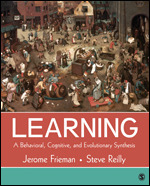Learning
A Behavioral, Cognitive, and Evolutionary Synthesis
- Jerome Frieman - Kansas State University, USA
- Steve Reilly - University of Illinois at Chicago, USA
Learning
Supplements
Calling all instructors!
It’s easy to log on to SAGE’s password-protected Instructor Teaching Site at study.sagepub.com/frieman for complete and protected access to all text-specific Instructor Resources for Learning: A Behavioral, Cognitive, and Evolutionary Synthesis by Jerome Frieman and Stephen Reilly. Simply provide your institutional information for verification and within 72 hours you’ll be able to use your login information for any SAGE title!
Password-protected Instructor Resources include the following:
- A Microsoft® Word® test bank is available containing multiple choice, true/false, short answer, and essay questions for each chapter. The test bank provides you with a diverse range of pre-written options as well as the opportunity for editing any question and/or inserting your own personalized questions to effectively assess students’ progress and understanding.
- A Respondus electronic test bank is available and can be used on PCs. The test bank contains multiple choice, true/false, short answer, and essay questions for each chapter and provides you with a diverse range of pre-written options as well as the opportunity for editing any question and/or inserting your own personalized questions to effectively assess students’ progress and understanding. Respondus is also compatible with many popular learning management systems so you can easily get your test questions into your online course.
- Editable, chapter-specific Microsoft® PowerPoint® slides offer you complete flexibility in easily creating a multimedia presentation for your course.
- An Instructor’s Manual helps you see the book's overall organization so that you can anticipate what comes next and what you need to emphasize in your classroom presentations. Important concepts are highlighted for you as they appear in the book, and their links to other chapters are noted; difficult concepts are also identified based on what students tend to find most challenging. The manual also includes overviews, chapter outlines, and key terms to assist with lecture preparation and review.
- New discussion questions cover key concepts and issues appropriate for classroom discussion.
- Lively and stimulating class assignments can be used in class to reinforce active learning. The activities apply to individual or group projects.
Use the Student Study Site to get the most out of your course!
Our Student Study Site at study.sagepub.com/frieman is completely open-access and offers a wide range of additional features, including something no other publisher offers: SAGE Journal articles!
The open-access Student Study Site includes the following:
- Mobile-friendly eFlashcards reinforce understanding of key terms and concepts that have been outlined in the chapters.
- Mobile-friendly web quizzes allow for independent assessment of progress made in learning course material.
- Each chapter includes video and multimedia links related to important topics and designed to supplement key points within the text.
- Web resources are included for further research and insights.
- EXCLUSIVE! Access to certain full-text SAGE journal articles have been carefully selected for each chapter. Each article supports and expands on the concepts presented in the chapter. This feature also provides questions to focus and guide your interpretation.
- Web exercises direct you to useful and current web resources, along with creative activities to extend and reinforce learning or allow for further research on important chapter topics.
Dpt chose other Sage text (Klein)
I like the text very much except it is extremely skewed toward Behavioral theory of learning. Very little is addressed with regard to other major learning theories. If I were teaching course on ABA's, I would consider using this text; however, I need to be able to teach students that there is more than just one theory out there.

